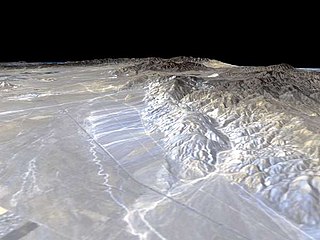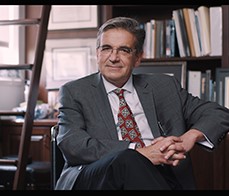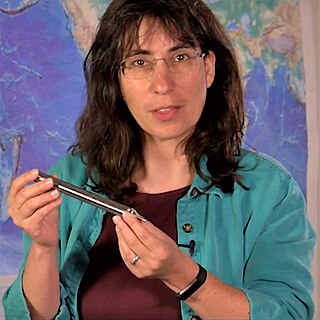Related Research Articles

In geology, a fault is a planar fracture or discontinuity in a volume of rock across which there has been significant displacement as a result of rock-mass movements. Large faults within Earth's crust result from the action of plate tectonic forces, with the largest forming the boundaries between the plates, such as the megathrust faults of subduction zones or transform faults. Energy release associated with rapid movement on active faults is the cause of most earthquakes. Faults may also displace slowly, by aseismic creep.

The Garlock Fault is a left-lateral strike-slip fault running northeast–southwest along the north margins of the Mojave Desert of Southern California, for much of its length along the southern base of the Tehachapi Mountains.

Fault mechanics is a field of study that investigates the behavior of geologic faults.

In geology, aseismic creep or fault creep is measurable surface displacement along a fault in the absence of notable earthquakes. Aseismic creep may also occur as "after-slip" days to years after an earthquake. Notable examples of aseismic slip include faults in California.

The stick–slip phenomenon, also known as the slip–stick phenomenon or simply stick–slip, is a type of motion exhibited by objects in contact sliding over one another. The motion of these objects is usually not perfectly smooth, but rather irregular, with brief accelerations (slips) interrupted by stops (sticks). Stick–slip motion is normally connected to friction, and may generate vibration (noise) or be associated with mechanical wear of the moving objects, and is thus often undesirable in mechanical devices. On the other hand, stick–slip motion can be useful in some situations, such as the movement of a bow across a string to create musical tones in a bowed string instrument.

In geology, a slickenside is a smoothly polished surface caused by frictional movement between rocks along a fault. This surface is typically striated with linear features, called slickenlines, in the direction of movement.
Episodic tremor and slip (ETS) is a seismological phenomenon observed in some subduction zones that is characterized by non-earthquake seismic rumbling, or tremor, and slow slip along the plate interface. Slow slip events are distinguished from earthquakes by their propagation speed and focus. In slow slip events, there is an apparent reversal of crustal motion, although the fault motion remains consistent with the direction of subduction. ETS events themselves are imperceptible to human beings and do not cause damage.
Thomas H. (Tom) Heaton is an American seismologist, known for his influential contributions in earthquake source physics and earthquake early warning. Currently he is the professor of geophysics and civil engineering at California Institute of Technology (Caltech) and one of the world’s leading experts on seismology.

Ares J. Rosakis, Theodore von Kármán Professor of Aeronautics and Professor of Mechanical Engineering at the California Institute of Technology. He was also the fifth Director of the Graduate Aerospace Laboratories, known as (GALCIT), and formerly known as Guggenheim Aeronautical Laboratory, and was the Otis Booth Leadership Chair, of the Division of Engineering and Applied Science.
In seismology, an earthquake rupture is the extent of slip that occurs during an earthquake in the Earth's crust. Earthquakes occur for many reasons that include: landslides, movement of magma in a volcano, the formation of a new fault, or, most commonly of all, a slip on an existing fault.

The Xianshuihe fault system or the Yushu-Ganzi-Xianshuihe fault system is a major active sinistral (left-lateral) strike-slip fault zone in southwestern China, at the eastern edge of the Tibetan Plateau. It has been responsible for many major earthquakes, and is one of the most seismically active fault zones in China.
An asperity is an area on an active fault where there is increased friction, such that the fault may become locked, rather than continuously slipping as in aseismic creep. Earthquake rupture generally begins with the failure of an asperity, allowing the fault to move.

Emily E. Brodsky is a Professor of Earth Sciences at the University of California, Santa Cruz. She studies the fundamental physical properties of earthquakes, as well as the seismology of volcanoes and landslides. In 2023, she was elected to the National Academy of Sciences.
Jean Marie Carlson is a professor of complexity at the University of California, Santa Barbara. She studies robustness and feedback in highly connected complex systems, which have applications in a variety of areas including earthquakes, wildfires and neuroscience.
Joan S. Gomberg is a research geophysicist at the United States Geological Survey. She serves as an adjunct professor at the University of Washington. She is interested in subduction zone science, and studies how earthquakes trigger each other and how faults can slip. Gomberg is a Fellow of the American Geophysical Union. She was the first person to demonstrate how dynamic stress associated with seismic waves can trigger other earthquakes.
Michel Campillo is a French seismologist and geophysicist who is currently a professor at Grenoble Alpes University.

The Haiyuan Fault is a major active intracontinental strike-slip (sinistral) fault in Central Asia.
The 1992 Kohat earthquake struck Khyber Pakhtunkhwa Province in Pakistan on May 20. The Mw 6.3 earthquake inflicted significant damage in the nearby city Kohat. An estimated 36 people died and 100 were injured in the Peshawar and Kohat districts. Four-hundred (400) homes were wiped out, affecting 2,100 residents in the region.

The earthquake cycle refers to the phenomenon that earthquakes repeatedly occur on the same fault as the result of continual stress accumulation and periodic stress release. Earthquake cycles can occur on a variety of faults including subduction zones and continental faults. Depending on the size of the earthquake, an earthquake cycle can last decades, centuries, or longer. The Parkfield portion of the San Andreas fault is a well-known example where similarly located M6.0 earthquakes have been instrumentally recorded every 30–40 years.
Toshihiko Shimamoto is a Japanese seismologist and professor of earthquake science at the Institute of Geology in Beijing and affiliated researcher at Kyoto University. His experimental research has contributed significantly to our understanding of earthquake mechanics.
References
- 1 2 3 "Caltech Division of Engineering and Applied Science | News | Greater Insight into Earthquake Cycles". eas.caltech.edu. Retrieved 2019-04-13.
- 1 2 3 "2002 Outstanding Doctoral Thesis Work". www.aps.org. Retrieved 2019-04-13.
- ↑ "Caltech Division of Engineering and Applied Science | ENGenious | Issue 3 | New Faculty". eas.caltech.edu. Retrieved 2019-04-13.
- ↑ Lapusta, Nadia (2001). "Elastodynamic analyses of sliding with rate and state friction". Ph.D. Thesis. Bibcode:2001PhDT.......125L.
- ↑ "Nadia Lapusta | Caltech Directory". directory.caltech.edu. Retrieved 2019-04-13.
- ↑ "Nadia Lapusta - Caltech Seismological Laboratory". www.seismolab.caltech.edu. Retrieved 2019-04-13.
- ↑ "Caltech Mechanical and Civil Engineering | Nadia Lapusta". www.mce.caltech.edu. Retrieved 2019-04-13.
- ↑ "Nadia Lapusta - Caltech". lapusta.caltech.edu. Retrieved 2019-04-13.
- ↑ "Nadia Lapusta". web.gps.caltech.edu. Retrieved 2019-04-13.
- ↑ "NSF Award Search: Award#0548277 - CAREER: Integrated Program of Multidisciplinary Education and Research in Mechanics and Physics of Earthquakes". www.nsf.gov. Retrieved 2019-04-13.
- 1 2 3 "Faulty behavior: New earthquake fault models show that 'stable' zones may contribute to the generation of massive earthquakes". ScienceDaily. Retrieved 2019-04-13.
- ↑ Noda, Hiroyuki; Lapusta, Nadia (2013-01-24). "Stable creeping fault segments can become destructive as a result of dynamic weakening". Nature. 493 (7433): 518–521. Bibcode:2013Natur.493..518N. doi:10.1038/nature11703. ISSN 0028-0836. PMID 23302798. S2CID 4429849.
- ↑ Nadia Lapusta; Noda, Hiroyuki (January 2013). "Stable creeping fault segments can become destructive as a result of dynamic weakening". Nature. 493 (7433): 518–521. Bibcode:2013Natur.493..518N. doi:10.1038/nature11703. ISSN 1476-4687. PMID 23302798. S2CID 4429849.
- ↑ "Caltech Division of Engineering and Applied Science | News | Aseismic Slip as a Barrier to Earthquake Propagation". eas.caltech.edu. Retrieved 2019-04-13.
- ↑ "Caltech Division of Engineering and Applied Science | News | Winners of the 2016 Demetriades - Tsafka - Kokkalis Prizes Announced". eas.caltech.edu. Retrieved 2019-04-13.
- 1 2 "NSF Award Search: Award#1651235 - Investigating dynamic friction using earthquake ruptures produced in the laboratory". www.nsf.gov. Retrieved 2019-04-13.
- ↑ "Keynote speakers | MultiScale Material Science for Energy and Environment". umi.mit.edu. Retrieved 2019-04-13.
- ↑ "Caltech Division of Engineering and Applied Science | News | Professor Lapusta Receives GSC Mentoring Award". eas.caltech.edu. Retrieved 2019-04-13.